Figure 1.
Scenario example for the simulated branching process. Initially, there is one infected person A who does not wear a mask and who was infected at time . A infected B before the symptoms onset, who then infects C after symptom onset and is isolated with a certain delay. In its turn, the new case C infects several people before it is isolated. However, since the case C is traced, its time of isolation comes earlier than it would have been without tracing (for this example, the isolation time coincides with the appearance of symptoms). Case B, unlike case C, is not traced, but the person wears a mask, which reduces the number of secondary cases that it can produce: instead of three new cases, B infects only two (E and F cases). In this example, we suppose the mask can be used for source control and for the protection of healthy persons from infection with some efficiency . Therefore, the person F does not get infected because of the mask, while for person E, the mask does not work, and E becomes infected. Thus, case B, instead of the possible three potential new cases, produces only one new case.

